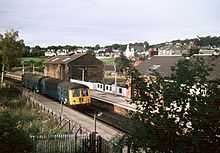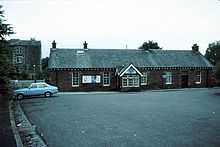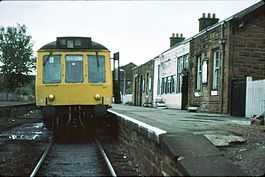Kilmacolm railway station
| Kilmacolm | |
|---|---|
|
Kilmacolm railway station in 1979 | |
| Location | |
| Place | Kilmacolm |
| Area | Inverclyde |
| Coordinates | 55°53′35″N 4°37′46″W / 55.8931°N 4.6295°WCoordinates: 55°53′35″N 4°37′46″W / 55.8931°N 4.6295°W |
| Operations | |
| Original company | Greenock and Ayrshire Railway |
| Pre-grouping | Glasgow and South Western Railway |
| Platforms | 2 |
| History | |
| 23 December 1869 | Opened as Kilmacolm[1] |
| 1 December 1904 | Renamed: Kilmacolm G&SW[1] |
| 1907 | Station largely Rebuilt |
| 2 February 1959 | Became Terminal passenger station of Paisley Canal Line |
| 10 January 1983 | Closure[1] |
| Disused railway stations in the United Kingdom | |
|
Closed railway stations in Britain A B C D–F G H–J K–L M–O P–R S T–V W–Z | |
| UK Railways portal | |
Kilmacolm railway station was a railway station serving the village of Kilmacolm, in the current council area of Inverclyde and the historic country of Renfrewshire in the West-Central Lowlands of Scotland. It was originally part of the Greenock and Ayrshire Railway, later a line of the Glasgow and South Western Railway.
History


The station was opened by the Greenock and Ayrshire Railway Company on 23 December 1869, as Kilmacolm; however on 1 December 1904 it was renamed Kilmacolm G&SW.[1] The station was largely rebuilt in 1907.[2]
The main traffic was for commuters from this affluent village to Glasgow and Paisley. It was said that the early train was for the "strivers", the second train, which would arrive in time to reach city centre offices by about 9am, for the "thrivers" and the third train for the company directors, senior stockbrokers etc - the "drivers".
On 2 February 1959, stopping passenger services from Glasgow and Paisley ceased running beyond Kilmacolm; however, the Glasgow St Enoch to Greenock Prince's Pier Ocean Liner boat trains continued running, without stopping, through the station until 30 November 1965.[3]
The station and the rest of the line closed on 10 January 1983.[1]
Current and future use
The former site of the station is now occupied by a tavern.[2]
The former railway line serving Kilmacolm station has been converted into a cycle path, and is now part of the Clyde to Forth cycle route (National Cycle Route 75). The route of the line has been preserved, and has been confirmed by Strathclyde Partnership for Transport to be available for use again should future redevelopment of the line be considered.[4]
| Preceding station | Historical railways | Following station | ||
|---|---|---|---|---|
| Port Glasgow Upper Line and station closed |
Glasgow and South Western Railway Greenock and Ayrshire Railway |
Bridge of Weir Line and station closed | ||
Notes
References
- Butt, R. V. J. (1995). The Directory of Railway Stations: details every public and private passenger station, halt, platform and stopping place, past and present (1st ed.). Sparkford: Patrick Stephens Ltd. ISBN 1-8526-0508-1. OCLC 60251199.
- Jowett, Alan (March 1989). Jowett's Railway Atlas of Great Britain and Ireland: From Pre-Grouping to the Present Day (1st ed.). Sparkford: Patrick Stephens Ltd. ISBN 1-8526-0086-1. OCLC 22311137.
- Thomas, John (1971). A Regional History of the Railways of Great Britain. VI Scotland: The Lowlands and the Borders (1st ed.). Newton Abbot, Devon: David & Charles. ISBN 0-7153-5408-6. OCLC 16198685.
- Thomas, John; Paterson, Rev A. J. S. (1984). A Regional History of the Railways of Great Britain. VI Scotland: The Lowlands and the Borders (2nd ed.). Newton Abbott, Devon: David & Charles. ISBN 0-9465-3712-7. OCLC 12521072.
- Wham, Alasdair (2000). The Lost Railway Lines South of Glasgow. Wigtown: G.C. Book Publishers. ISBN 1-8723-5008-9.
